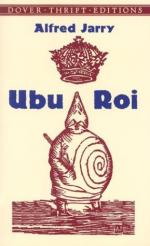|
This section contains 4,389 words (approx. 15 pages at 300 words per page) |

|
SOURCE: Vickroy, Laurie. “Ubu-en-procès: Jarry, Kristeva, and Semiotic Motility.” Modern Language Studies 20, no. 2 (spring 1990): 10-18.
In the following essay, Vickroy demonstrates that Julia Kristeva's theory of “semiotic motility”—which does not presuppose that meaning preceding language—provides a useful methodology for reading Jarry's Ubu Roi, which creates neologisms with the effect of undercutting preconceptions about meaning and symbol.
Père Ubu is, without a doubt, semiotic motility personified. Like Alfred Jarry, whose strange behavior has by now been well-documented, Ubu exemplifies Julia Kristeva's vision of the “semiotized body as place of permanent scission.”1 Her theory of the subject, with its emphasis on the sujet-en-procès (in process/on trial) and the continuing interplay between what she calls the semiotic and the symbolic, has already been applied to certain texts of avant-garde writers (i.e. Mallarmé, Joyce, Lautréamont), but nowhere have the conflicting forces manifested themselves more...
|
This section contains 4,389 words (approx. 15 pages at 300 words per page) |

|


